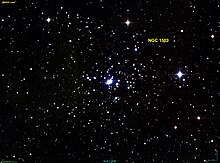
Back NGC 1502 Arabic NGC 1502 AST NGC 1502 Azerbaijani NGC 1502 Byelorussian NGC 1502 BS NGC 1502 CE NGC 1502 Czech NGC 1502 German NGC 1502 DIQ NGC 1502 Greek
 The location of NGC 1502 (circled) | |
| Observation data (J2000 epoch) | |
|---|---|
| Right ascension | 04h 07m 48.96s[1] |
| Declination | +62° 19′ 55.2″[1] |
| Distance | 3,452 ly (1,058.4 pc)[1] 3,643+313 −290 ly (1,117+96 −89 pc)[2] |
| Apparent magnitude (V) | 6.0[3] |
| Apparent dimensions (V) | 9.7′[1] |
| Physical characteristics | |
| Radius | 5.5 ly (1.7 pc)[4] |
| Estimated age | 5 Myr[2] |
| Other designations | NGC 1502,[5] Cr 45 |
| Associations | |
| Constellation | Camelopardalis |

NGC 1502 (also known as the Golden Harp Cluster[6]) is a young[7] open cluster of approximately 60[3] stars in the constellation Camelopardalis, discovered by William Herschel on November 3, 1787.[8] It has a visual magnitude of 6.0 and thus is dimly visible to the naked eye.[3] This cluster is located at a distance of approximately 3,500 light years[1][2] from the Sun, at the outer edge of the Cam OB1 association of co-moving stars, and is likely part of the Orion Arm.[2] The asterism known as Kemble's Cascade appears to "flow" into NGC 1502, but this is just a chance alignment of stars.[9]
The Trumpler class of NGC 1502 is II3p, indicating poorly populated cluster of stars (p) with a wide brightness range (3). The main sequence turnoff point is not well-defined, so the age estimates range from five to fifteen million years.[7] It is heavily reddened due to interstellar dust.[4] One of the brightest candidate members of the cluster is the eclipsing binary SZ Cam, which is a component of a visual double star ADS 2984.[2] There are eleven variable stars and four candidate variables among the cluster members, including a β Cep, two periodic B-type variables, 2–3 eclipsing variables, and an RR Lyrae star.[7] Five members of the cluster are chemically peculiar.[10]
- ^ a b c d e Cite error: The named reference
Cantat-Gaudin_Anders_2020was invoked but never defined (see the help page). - ^ a b c d e Cite error: The named reference
Topasna_et_al_2018was invoked but never defined (see the help page). - ^ a b c Cite error: The named reference
O'Meara2007was invoked but never defined (see the help page). - ^ a b Cite error: The named reference
Tripathi_et_al_2013was invoked but never defined (see the help page). - ^ Cite error: The named reference
Simbadwas invoked but never defined (see the help page). - ^ Stoyan, Ronald; Schurig, Stephan (2014). interstellarum Deep Sky Atlas. Erlangen: Cambridge University Press; Oculum-Verlag GmbH. ISBN 978-1-107-50338-0. OCLC 920437579.
- ^ a b c Cite error: The named reference
Michalska_et_al_2009was invoked but never defined (see the help page). - ^ Cite error: The named reference
Seligmanwas invoked but never defined (see the help page). - ^ Cite error: The named reference
Thompson2007was invoked but never defined (see the help page). - ^ Cite error: The named reference
Paunzen_et_al_2005was invoked but never defined (see the help page).
© MMXXIII Rich X Search. We shall prevail. All rights reserved. Rich X Search